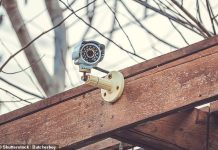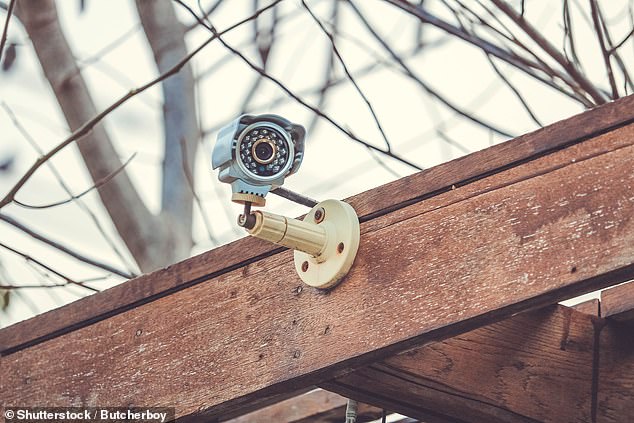Households are increasingly turning to home security cameras to protect their homes as the cost of technology drops and installations become simpler.
Demand for home closed-circuit television (CCTV) systems is predicted to rise by 20 per cent over the next five years, according to data analyst Grand View Research.
By this time half of households could be using them
Demand typically peaks between October and December as the darker evenings lead to an increase in break ins.
But you don’t have to spend a fortune.
Here, home security experts share their six top tips to get the best system for your home.

Protection: Demand for home closed-circuit television systems is predicted to rise by 20% over the next five years
1. Features you may need
Experts agree a couple of outside cameras might be enough for a basic system covering a front door entrance area and rear garden.
Modern cameras have motion sensors but Chris Dawson, sales manager for Spy Alarms in Orpington, Kent, says you should consider one that also uses infrared technology that can see in the dark and show images on a camera you might not be able to see with the naked eye.
He says: ‘Beware the highest quality image – such as 40 mexapixels – might have a better digital resolution but operates worse in low light.
‘We often recommend 5 megapixel cameras that still capture sharp images but use less storage space.’
While two outside cameras may be enough – offering a clear view of people coming to the door or entering from the rear of the house, if your home is beside a public walkway and you have a flat roof that could be climbed, these are further areas that will benefit from surveillance, warns Dawson.
He adds: ‘Anyone can put up a camera, but it is where you place it that is important.’
2. Take a look at the experts’ favourites
Consumer body Which? recently tested a range of security cameras that you can fit yourself – marking the EufyCam S3 Pro as the top ‘best buy’.
It was highly rated for video and sound quality as well as ease of use. The two-camera system costs £499.

Crystal ball: Spy Alarm’s Chris Dawson believes expert guidance is vital when picking a security system for your future needs
For those on a tight budget Which? gave the £57.85 TP-Link Tapo C520WS single camera option its best buy accreditation.
Natalie Hitchins, of Which?, says: ‘Our tests check for video and audio quality, motion detection sensitivity and how easy the cameras are to install – but some need to be wired into the mains by an electrician.’
John Oakins, co-owner of security camera fitting company Hertford TV Service, rates SPRO cameras as among the best due to quality and after-sales support.
You can purchase a SPRO 4K 8MP bundle with two cameras and hard drive storage from £356.
For those looking at budget DIY solutions, Oakins suggests a £130 Ring video doorbell as a great deterrent – although there is a monthly fee of between £5 and £16 – depending on the features you opt for – if you want video stored.
Dawson rates firms such as Axis for quality reliable equipment, with an Axis P1455-LE outdoor camera costing £564.
At the budget end he rates Motorola, where a Motorola Focus 72 Connect Outdoor camera can cost £25. Another highly rated maker is Bosch – its Flexidome outdoor camera system costs £292.
3. Do not opt for the most expensive system
The dizzying array of security camera options can leave your head in a spin – but experts agree buying the most expensive is a mistake.
‘Pick the right tools for the job,’ says Dawson.

Deterrent: Knowing where to fit your spy camera is key to how well it detects burglars
He is concerned many people over complicate the process by investing in systems with bells and whistles that are simply unnecessary – while others cut corners.
He says: ‘Do you need a set up with an Artificial Intelligence computer that tells you when someone in a hat passes by – or a cheap plug-and-play gadget from a DIY store?
‘The answer for both is most probably not, but something in between.’
Dawson adds that reliable cameras by manufacturers such as Dahua can cost under £100 each and can be fitted yourself and hooked up to a £100 surveillance system that can be monitored from your smartphone.
Alternatively, if you prefer to have a system installed by security professionals, it can cost around £650 for a two-camera system.
4. Choose between wireless or mains connected
Previously you had to connect sensors and cameras with wires that were often put inside your home walls – so they were more bother to install.
However, wireless options are increasingly popular, which are controlled using wifi.
Dawson adds: ‘It is usually far easier to add extra features, such as an extra security camera, to a system that is already wirelessly controlled.’
If you are going to fix a system up to mains electricity it will be necessary to call in professionals.
Which? points out that when wireless security cameras are installed, they are often plugged in to the mains electricity, even if they offer back-up batteries if there are power failures.
If you don’t like the idea of having your home under surveillance, simply installing a camera without switching it on may act as a deterrent, says Oakins.
Installing a CCTV system may also help bring down the cost of home insurance by up to 15 per cent according to price comparison website FreePriceCompare and security installation company Taun-Tech.
5. Beware hidden costs and privacy rules
There are two main types of security system. You either buy one with a recorder box and hold the footage on a hard drive yourself or you sign up to a subscription model where the footage is automatically sent to a firm over wifi and held by them.
Although a subscription model may look cheaper, they may be more expensive over the long term.
Oakins says: ‘Installing a system with at least a couple of cameras and a recorder box is the most cost-effective solution. This hard drive will typically store video footage for a month.
‘After this it can automatically re-record new footage unless you wish to keep the information and pass it on to the police.’

Tapo has been rated highly for ease of use
A recorder box with Oakins’ favoured SPRO system can cost £150 – which is separate to cameras that can cost £100 each. The box is the computer brain to which cameras are linked by wire or wi-fi.
This box can be kept somewhere secure inside the home. It can also be set up to send email alerts to your phone for unexpected activity.
A basic subscription to a service such as Amazon’s Ring costs £5 a month. This is a smart doorbell that contains a camera that monitors your front door.
If you want extras such as a ‘smart video search’ to trawl over three months’ worth of recordings, it will cost up to £16 a month (£192 a year).
Dawson adds it is important not to fall foul of General Data Protection Regulations (GDPR) rules – on how you collect and hold data on those caught on camera.
He says: ‘You should typically not hold information for more than 30 days and you cannot share what is caught with anyone else unless a potential crime.’
6. Make sure burglars cannot hack cameras
An outdoor camera needs to be secure enough to thwart potential hacking attacks as well, says Which? Otherwise criminals could disconnect a system online or even tap into the cameras to monitor what you see.
Ensure your camera’s software is always up to date and that if the equipment came with a default password this is changed.

Future proof: Try to stay one step ahead of hackers with cryptic password. The next step in CCTV security could be facial recognitio
Which? also points out that when wireless security cameras are installed, they are often plugged in to the mains electricity, even if they offer back-up batteries if there are power failures.
Mr Dawson says: ‘Previously you had to connect sensors and cameras with wires that were often put inside your home walls – so they were a lot more bother to install.
‘It is usually far easier to add extra features, such as an extra security camera, to a system that is already wirelessly controlled.’
SAVE MONEY, MAKE MONEY

Sipp cashback

Sipp cashback
Up to £2,000 cashback until 31 August
4.38% cash Isa
4.38% cash Isa
Trading 212: 0.53% fixed 12-month bonus

£20 off motoring

£20 off motoring
This is Money Motoring Club voucher

Investing Isa offer

Investing Isa offer
1% back (max £200) when adding £5,000+

No fees on 30 funds

No fees on 30 funds
Potentially zero-fee investing in an Isa or Sipp
Affiliate links: If you take out a product This is Money may earn a commission. These deals are chosen by our editorial team, as we think they are worth highlighting. This does not affect our editorial independence. Terms and conditions apply on all offers.
#demand #home #CCTV #soars #experts #offer #top #tips #fitting #spy #camera #budget
















